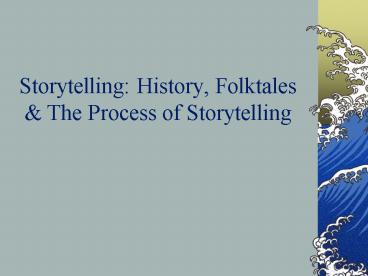Storytelling: History, Folktales - PowerPoint PPT Presentation
1 / 20
Title:
Storytelling: History, Folktales
Description:
Originally, storytelling was a community event and one of the few forms of ... Style sounds, rhythms, vivid word imagery. Dramatic appeal. Characterization ... – PowerPoint PPT presentation
Number of Views:3978
Avg rating:5.0/5.0
Title: Storytelling: History, Folktales
1
Storytelling History, Folktales The Process of
Storytelling
2
History
- Originally, storytelling was a community event
and one of the few forms of entertainment in
society. - Bards, minstrels, and raconteurs have reveled in
telling epic poems, stories and songs - Today storytellers are a respected part of world
culture.
3
The Role of The Storyteller
- Storytellers have played an integral role in many
cultures - Before written words, spoken words were the means
of communication - Words were the way history, laws, social mores
and moral truths were shared - Stories were the way to relay the these messages
to be easily understood
4
Social Functions
- Convey messages of local culture
- Dual functions working and entertaining to pass
the time and keep others alert during tedious
work - Fisherman while repair nets, boats in winter
- Stringing, smoothing and sorting tobacco
- Evening-making for communal tasks formerly
completed by families
5
Books, Industry Literacy
- The advent of books and education for the elite
relegated folktales to lower classes. - The spread of industry, literacy and culture
further marginalized folklore into the childrens
realm - Content evolved to embody hopes of less fortunate
and increased in variety
6
In Recent History
- Storytelling still serves many of the original
purposes - Storytelling also serves the purposes of literacy
and literary appreciation - Storytelling exposes listeners to sounds and
rhythms of words, the resonance of voice, the
sequence and parts of stories
7
In Libraries
- As early as 1899 Frances Jenkins Olcott made a
regular part of programs - For school aged children
- The arrival of Marie Shedlock in America brought
widespread appreciation for storytelling as an
art valued as a tool to bring books and children
together - Storytime became part of libraries nationwide
8
Folktales
- Three Principal Factors equally essential to the
existence of a folktale - Traditions or communal contribution of past
bearers of traditions - Present storytelling in the community
- The narrator
- Simultaneous interaction of the three factors
result in the development of the tale
9
Evolution
- Folktales evolve gradually
- Each telling reflects each new tellers
adaptations and nuances - So, the story becomes a cumulative, constant, and
not individual but collective - The traditional folktale served as a model,
molded by the teller, reflecting the community,
its interest and history.
10
Folktales are . . .
- Traditional tales passed down teller to teller
over time - Hallmarks
- Come to a swift conclusion
- full of actions carried out by main characters
- Simple and direct
- Relay ideas, customs, beliefs with amusement
11
Favorite Folktales
- Hobyahs
- Mollie Wuppie
- Three Billie Goats Gruff
- A Story, A Story
- The Gunniwolf
- The Gingerbread Man
12
The Storytelling Process
- Selection
- Sources
- Process
- Critique
13
Selection Choose Stories . . .
- The Power to choose involves knowledge of self,
knowledge of storytelling literature and
knowledge of the group to whom one is telling.
(Baker and Greene) - You like
- That have meaning for you
- That have something to say
14
Choosing The Story what makes a good one to tell?
- A good story has vision, integrity, something to
hold onto, and sound values that are implicit but
not didactic. - Characteristics of a good story
- A single, clearly defined theme
- Well-developed plot
- Style sounds, rhythms, vivid word imagery
- Dramatic appeal
- Characterization
- Faithfulness to the source
- Appropriate for the audience
15
Sources Finding The Story
- Start with the Basics
- Indexes Storytellers Sourcebook
- Story collections
- Picture books
- Read, Read, Read
- Different versions of the same tale from picture
books and collections
16
Process Learning The Story
- Read the story several times to learn the basic
plot. Reading more than one version helps in
developing unique telling. - Write the story down.
- Tape the story.
- Create a map of story sequences or outline the
major points. - Practice on a friend, as you drive
- Imagine the story without speaking
17
Developing The Story
- Think about the characters
- What kind of voices they have, what they look
like, whats unique about them - Let the characters speak for themselves
- Think about words
- Key phrases specific language
- Repeated phrases that allow participation or
for the teller to find their place
18
Honing The Story
- Storytelling as an intuitive process
- Trying the story on different audiences
- Letting go of the story after you have learned it
to make it unique
19
Critiquing The Story
- A positive peer group process
- Support listen with respect
- What works and something to grow on
- Remember the elements of a good story
- Be prepared to listen objectively
20
The Critique you your peers
- Rate The Storyteller excellent, good, fair,
poor - Intro
- Selection
- Mastery
- Interpretation
- Eye Contact
- Gestures
- Overall
- Comments































